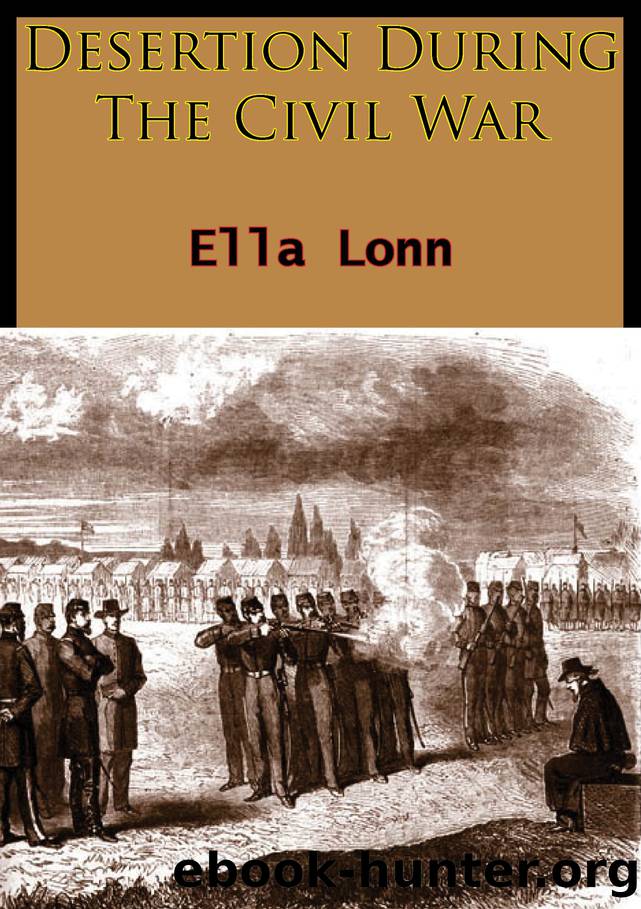Desertion During The Civil War by Lonn Ella;

Author:Lonn, Ella;
Language: eng
Format: epub
Publisher: Golden Springs Publishing
Published: 2016-01-18T00:00:00+00:00
CHAPTER XIâDEVICES FOR ESCAPE FROM THE UNION ARMY AND MEASURES OF PREVENTION
The Union soldier was as ingenious in devising methods for effecting his escape from a service which had become irksome to him as his Southern confrère, but certainly in the early stages he had less need of wile.
One of the earliest means scarcely deserves designation as a method; it was merely to refrain from returning from a sick leave or from a furlough. Evidently the abuse of the sick leave was a worry to Halleck while he was serving as a commander in the field, for in July, 1862, he directed that sick leaves cease, as they were destroying the army, for of the thousands sent off sick, scarcely any returned.{569} At about the same time McClellan was bringing the matter to the attention of Governor Morgan of New York, seeking that executiveâs help to secure the return of many thousands in the North who were fit to rejoin their regiments.{570} The former complained also to General Thomas that the convalescent soldiers habitually returned to their homes when allowed to leave the hospitals as convalescent. He accompanied his charge with the startling statement that it was the experience of every commander that not more than a tenth of the soldiers left behind sick ever returned to their companies. He cited as evidence the fact that a regiment stationed as depot guard with his army had sent some 500 sick to hospitals in the rear and had received back some fifteen or twenty.{571} It must be confessed that his statement is fairly well borne out by the figures of the medical director of the Army of the Potomac concerning hospitals located near Washington for about two months of the year 1862. Of the total number of patients, nearly 52,000, only about 7,000 were returned to duty, or somewhat more than an eighth; as compared with 7,000 convalescent men who returned to their posts, 597 deserted on the way.{572} Even when the physicians learned to retain near the front the men who would soon be able to return to duty, the latter would slip off in the night to escape service. Self-inflicted wounds are not a discovery of the modern factory workman, for this same medical director reports that about 5,000 sick and slightly wounded men, âmany of the latter self-mutilated,â did not go to the field hospitals according to orders but straggled to Fredericksburg at different times, relying upon the agents of the Sanitary Commission and other relief organizations for food, keeping as much as possible out of the way of the medical officers.{573} Well men made care of the sick a pretext for leaving the battlefield in the confusion incident to carrying away the wounded after a battle.{574} In taking care of the sick, the able-bodied managed to get on board hospital boats, as there was always confusion and haste in shipping and caring for the wounded after an engagement. There was, naturally, no time for nice examination of permits to pass here or there.
Download
This site does not store any files on its server. We only index and link to content provided by other sites. Please contact the content providers to delete copyright contents if any and email us, we'll remove relevant links or contents immediately.
In Cold Blood by Truman Capote(3138)
Steve Jobs by Walter Isaacson(2765)
The Innovators: How a Group of Hackers, Geniuses, and Geeks Created the Digital Revolution by Walter Isaacson(2499)
All the President's Men by Carl Bernstein & Bob Woodward(2264)
Lonely Planet New York City by Lonely Planet(2102)
The Room Where It Happened by John Bolton;(2032)
And the Band Played On by Randy Shilts(2014)
The Murder of Marilyn Monroe by Jay Margolis(1981)
The Poisoner's Handbook by Deborah Blum(1977)
The Innovators by Walter Isaacson(1971)
Lincoln by David Herbert Donald(1869)
A Colony in a Nation by Chris Hayes(1796)
Under the Banner of Heaven: A Story of Violent Faith by Jon Krakauer(1684)
Amelia Earhart by Doris L. Rich(1585)
The Unsettlers by Mark Sundeen(1584)
Birdmen by Lawrence Goldstone(1533)
Dirt by Bill Buford(1519)
Zeitoun by Dave Eggers(1517)
Decision Points by George W. Bush(1463)
